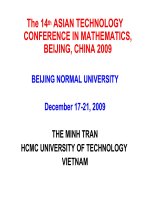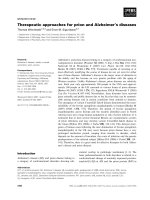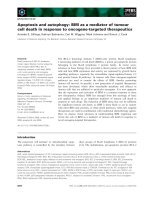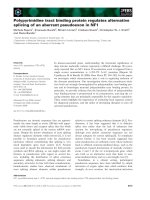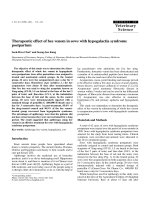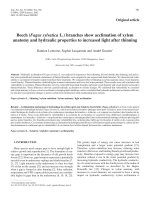Báo cáo khoa học: "Therapeutic hypothermia after cardiac arrest – the implementation of the ILCOR guidelines in clinical routine is possible" ppsx
Bạn đang xem bản rút gọn của tài liệu. Xem và tải ngay bản đầy đủ của tài liệu tại đây (28.71 KB, 2 trang )
Page 1 of 2
(page number not for citation purposes)
Available online />Therapeutic hypothermia after cardiac arrest is a treatment
with a high level of evidence. In 2003 the International Liaison
Committee on Resuscitation (ILCOR) recommended such
treatment for all comatose survivors of out-of-hospital cardiac
arrest when the initial rhythm was ventricular fibrillation [1].
However, recent studies have shown that only a minority of
resuscitated patients are treated with therapeutic hypothermia
in both American and European intensive care units [2-4]. A
letter recently published in Critical Care reported the use of
therapeutic hypothermia in Germany in only 38% of
departments treating patients after cardiac arrest [5].
To improve adherence to the ILCOR guidelines we
developed a written standard operating procedure (SOP) for
patients after cardiac arrest admitted to our 38-bed medical
intensive care unit.
Starting in December 2005 the SOP was to be applied to all
comatose patients after cardiac arrest, irrespective of the
initial rhythm. Since then the SOP has been applied in 28 out
of 34 eligible patients. For four patients the physician in
charge did not consider therapeutic hypothermia despite
clear indication. In two other patients hypothermia was
considered to be contraindicated because of extensive
coronary vasospasm or massive pulmonary bleeding of a
bronchial carcinoma, respectively. In all the remaining 28
patients surface cooling with technical devices (CritiCool
from MTRE, Yavne Israel, and ArcticSun from Medivance,
Louisville, KY, USA) was used to induce and maintain
hypothermia for 24 hours. The target temperature of 33°C
was reached in 6.0 ± 3.2 hours (mean ± SD).
In none of the patients were serious adverse events
potentially related to therapeutic hypothermia, such as
clinically relevant bleeding episodes or arrhythmias, observed.
In 12 out of 28 patients (42.9%) treated with therapeutic
hypothermia a favourable neurologic outcome was reached
(Cerebral Performance Category 1 or 2).
Although our limited experience does not yet permit a valid
statistical evaluation of the impact of therapeutic hypothermia
on the neurological outcome of the patients, initial results are
encouraging. We are currently trying to shorten the time to
target temperature, which we feel was still too long in some
patients. However, the simple availability of a written SOP
has already led to the application of therapeutic hypothermia
in the vast majority of our patients after cardiac arrest. All
physicians caring for such patients should be encouraged to
establish their own protocol for therapeutic hypothermia at
their institutions, to facilitate the widespread application of
this evidence-based treatment.
Competing interests
The authors declare that they have no competing interests.
References
1. Nolan JP, Morley PT, Vanden Hoek TL, Hickey RW, Kloeck WG,
Billi J, Bottiger BW, Morley PT, Nolan JP, Okada K, et al.: Thera-
peutic hypothermia after cardiac arrest: an advisory state-
ment by the advanced life support task force of the
International Liaison Committee on Resuscitation. Circulation
2003, 108:118-121.
2. Abella BS, Rhee JW, Huang KN, Vanden Hoek TL, Becker LB:
Induced hypothermia is underused after resuscitation from
cardiac arrest: a current practice survey. Resuscitation 2005,
64:181-186.
Letter
Therapeutic hypothermia after cardiac arrest – the implementation
of the ILCOR guidelines in clinical routine is possible!
Christian Storm, Joerg C Schefold, Lutz Nibbe, Frank Martens, Anne Krueger, Michael Oppert,
Achim Joerres and Dietrich Hasper
Charité Universitätsmedizin Berlin, Campus Virchow-Klinikum, Department of Nephrology and Medical Intensive Care Medicine, Augustenburger Platz
1, 13353 Berlin, Germany
Corresponding author: D Hasper,
Published: 2 November 2006 Critical Care 2006, 10:425 (doi:10.1186/cc5061)
This article is online at />© 2006 BioMed Central Ltd
See related letter by Sander et al., />ILCOR = International Liaison Committee on Resuscitation; SOP = standard operating procedure.
Page 2 of 2
(page number not for citation purposes)
Critical Care Vol 10 No 6 Storm et al.
3. Merchant RM, Soar J, Skrifvars MB, Silfvast T, Edelson DP,
Ahmad F, Huang KN, Khan M, Vanden Hoek TL, Becker LB, et al.:
Therapeutic hypothermia utilization among physicians after
resuscitation from cardiac arrest. Crit Care Med 2006,
34:1935-1940.
4. Laver SR, Padkin A, Atalla A, Nolan JP: Therapeutic hypother-
mia after cardiac arrest: a survey of practice in intensive care
units in the United Kingdom. Anaesthesia 2006, 61:873-877.
5. Sander M, von Heymann C, Spies C: Implementing the Interna-
tional Liaison Committee on Resuscitation guidelines on
hypothermia after cardiac arrest. The German experience: still
a long way to go? Crit Care 2006, 10:407.
